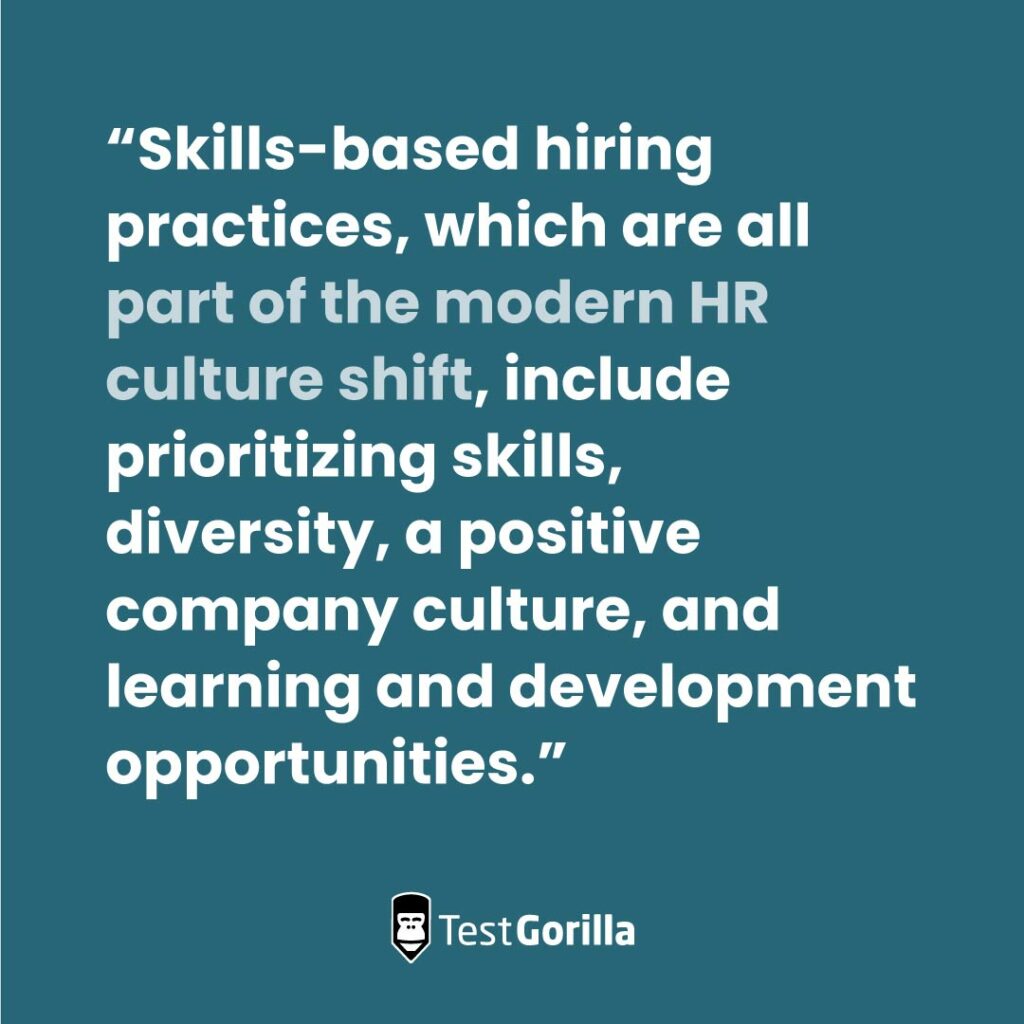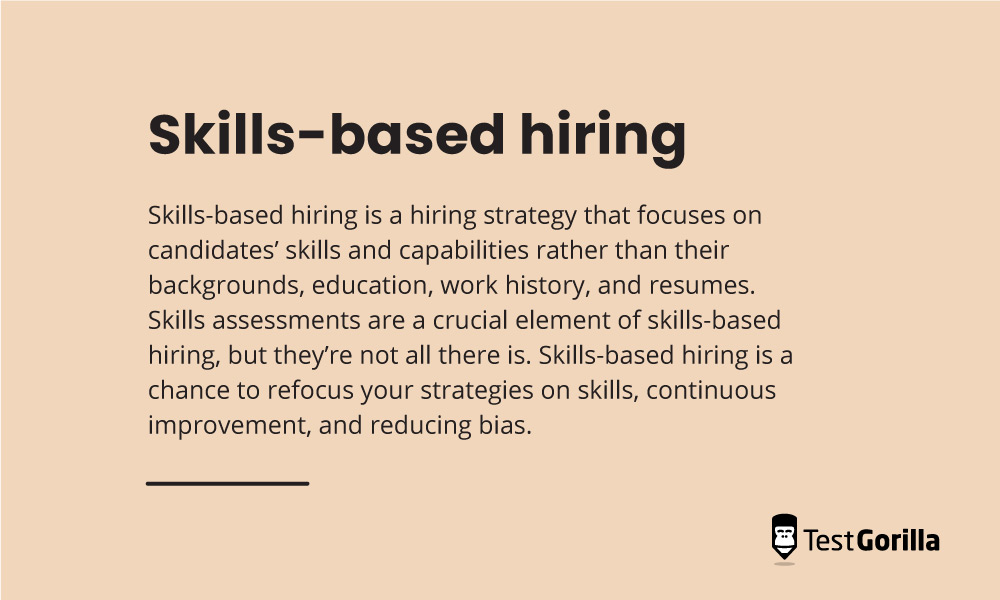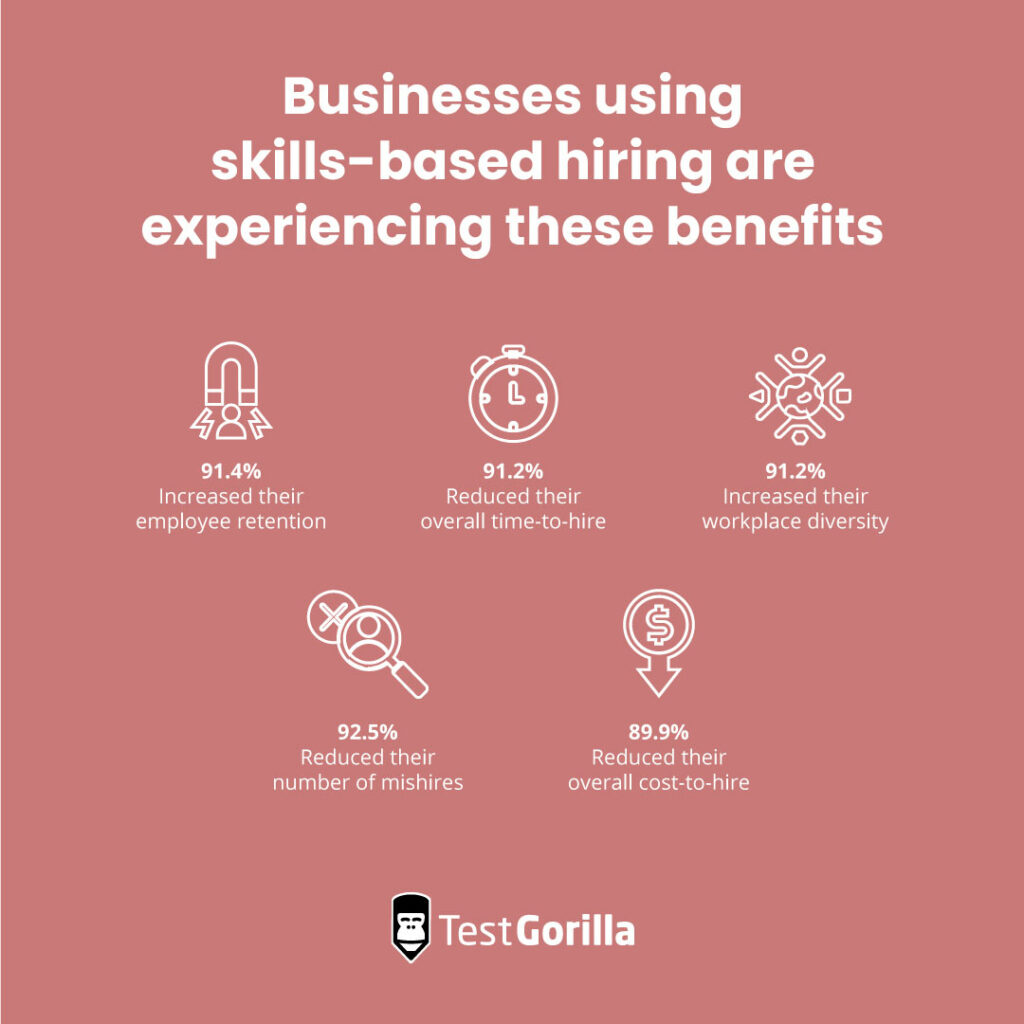Is skills-based hiring just about adding skills assessments to your current approach?
What is skills-based hiring? Let’s look at two possible answers:
It’s simply adding skills tests and assessments to a pre-existing strategy
It’s a fundamental rethink of your HR and people strategy
Too many people answer number one – and they’re going to miss out on what skills-based hiring can deliver.
Adding assessments to an untouched, traditional hiring process means that otherwise excellent candidates will continue to be filtered out due to unconscious bias and other irrelevant factors.
Skills tests are certainly important in a skills-based approach, but it’s also crucial to adopt the mindset and practices of a skills-based organization.
Skills-based hiring practices, which are all part of the modern HR culture shift, include prioritizing skills, diversity, a positive company culture, and learning and development opportunities.
This article answers the question of why tacking skills tests onto your current strategy isn’t as effective as a complete skills-based overhaul of your processes.
It also discusses the factors of a complete skills-based approach and how they benefit your company.
Table of contents
What is skills-based hiring?
Skills-based hiring is a hiring strategy that focuses on candidates’ skills and capabilities rather than their backgrounds, education, work history, and resumes.
Skills assessments are a crucial element of skills-based hiring, but they’re not all there is. By planning to use skills-based hiring for your future open jobs, you can refocus your strategies on skills, continuous improvement, and reducing bias.
It’s called skills-based hiring because the focus on skills acts as a base for all the other hiring factors.
For most skills-based organizations, this means a shift away from the resume. Resumes have been a consistent part of the hiring process since the 1950s, but they’ve overstayed their welcome.
It was in the mid-2010s that increasingly more people began to question the efficacy of resumes and point to their discriminatory potential.
By this time, we had also been dealing with degree inflation for a little over a decade.
People were starting to challenge the status quo and demand more fair and effective hiring processes. The answer was skills-based hiring. For an in-depth analysis of this topic, read our article on the history of skills-based hiring.
This shift has been amazingly successful. According to TestGorilla’s State of Skills-Based Hiring report, 76% of companies used skills-based hiring practices in 2022.
Our report also found that businesses using skills-based hiring are experiencing these benefits:
91.2% increased workplace diversity
91.2% reduced overall time-to-hire
91.4% increased worker retention
92.5% reduced the number of mis-hires
89.9% reduced overall cost-to-hire
Skills-based practices are the future of hiring. To explore the advantages in-depth, read our article on the business benefits of skills-based hiring.
Why you shouldn’t simply add skills tests to a traditional strategy
Skills tests are a crucial element in a skills-based strategy, but they won’t be as effective if you toss them into a pre-existing, traditional hiring strategy and hope for the best.
If you add skills tests to your current, unchanged approach, it could be detrimental in many ways:
Resumes still filter out great candidates
Degree and experience requirements exclude excellent non-traditional candidates
Unstructured interviews leave room for bias
Internal mobility, upskilling, and reskilling aren’t as smooth and efficient in the absence of skill-based processes
A traditional process isn’t based on a foundation of skills, which means that you can still miss top talent due to reliance on resumes, work history, educational certifications, and unstructured interviews.
Yes, something as simple as an unstructured interview can filter out candidates owing to our perception of confidence and charisma as potential and skill.
One of the most problematic parts of a traditional hiring strategy is reliance on resumes. Resumes are an opportunity for gender, class, and race biases.[1]
A study by the University of California found that resumes with Black-sounding names got 10% fewer responses from employers. Despite similar qualifications, names like Lakisha and Jamal received fewer callbacks than names like Emily and Greg.
This unconscious bias stifles diversity efforts and causes us to miss out on top talent. It’s the perfect example of why adding skills tests to a traditional process isn’t enough to reap the benefits of skills-based hiring.
Skills-based hiring is when an employer values skills and capabilities over any other credential or detail, so it is more than tests and assessments.
Skills-focused employers look at motivation, soft skills, transferable skills, culture add, and future potential, not just pre-existing experience.
This last point is important. A candidate’s potential is crucial in skills-based hiring, meaning that a skills-based organization needs a strong belief in upskilling, continuous improvement, and career growth.
But all of these points are simply a part of the working landscape. Let’s talk about it.
The best insights on HR and recruitment, delivered to your inbox.
Biweekly updates. No spam. Unsubscribe any time.
Skills-based hiring is part of a complete HR culture shift
Skills-based hiring is changing our thoughts about HR, recruitment, and work itself. These beliefs and values are essential elements in a larger shift towards a new HR landscape.
This culture shift includes:
Learning and development
Continuous growth
A healthy, inclusive culture
This shift has been in the works for some time, but the Great Reshuffle and Great Discontent have caused the sudden surge in changes.
Millions of employees are shuffling from company to company because they want a healthier culture, more learning opportunities, and flexible work. Businesses need to overhaul and modernize their processes to attract and retain talent.
Skills-based hiring is an important part of this complete cultural shift that isn’t just about skills tests – it’s about becoming a skills-based organization that considers people and skills, not rigid roles.
According to Deloitte, these are the four best practices that skills-based companies follow:
Moving work from its traditional confines to a more fluid structure
Reconceiving workers from being “workers in roles” to “workers with skills and responsibilities”
Using skills to make decisions about work
Building a “skills hub” of common skills terminology and a skills database
A key aspect of skills-based hiring is breaking specific job roles into tasks and the problems they solve, then writing job descriptions and making job decisions based on skills and capabilities. These decisions comprise:
Learning and development
Rewards and compensation
Talent acquisition
Performance management
Workforce planning
Leadership planning
These changes are big but also a necessary, positive cultural shift. They create growth, letting workers advance in their careers and enabling employers to scale their workforce with top talent.
For more information on this shift, check out our article about the changing roles of managers in skills-first organizations.
The factors in a complete skills-based approach and how it’s more effective
Skills-based hiring isn’t just a synonym for skills tests but also an independent hiring strategy.
Let’s take a look at the six essential factors in a skills-based approach and how they benefit your organization.
Here’s a quick list of the elements we’ll explore:
Upskilling and reskilling
Positive corporate cultures
Diversity and inclusion
Flexibility
Employee wellbeing
Longer-term employer-employee relationships
1. Upskilling and reskilling
Upskilling and reskilling go hand-in-hand with a skills-based approach. You can’t focus on employee skills unless you’re acknowledging and encouraging growth.
Career growth is no longer a “nice-to-have” and modern workers demand learning opportunities in their work.
Solid professional development is one of the largest factors driving the Great Reshuffle. A 2021 report found that a need to develop and advance one’s career is the largest cause of voluntary attrition.
Other studies have found that 48% of workers would switch companies if another job offered learning opportunities and that learning and development opportunities were one of the top two priorities for choosing a new role, along with work-life balance.
Modern HR practices must shift focus to upskilling and reskilling to attract and retain today’s talent. The two practices contain a myriad of other benefits, too.
Upskilling and reskilling boost morale, create a more flexible, agile workforce, and improve your company’s brand image.
For more insights on professional growth, read our article on upskilling and reskilling.
2. Positive corporate cultures
A positive company culture is essential to adopting skills-based practices.
Negative corporate cultures cause more issues than you know. A toxic culture is the underlying cause of many problematic HR trends, such as quick quitting, quiet quitting, and quiet firing.
According to a study by MIT Sloan, a toxic culture is also the greatest driver of employee attrition – 10.4 times higher than compensation issues.
Skills-based hiring (and the culture shift it brings) creates a better, safer workplace and a healthier company culture centered on inclusivity, real skill, and a level playing field.
Skills-based practices also help build this culture through personality and culture tests.
These tests help you build a healthy culture of employees with similar values but distinct lifestyles and beliefs – this is called “culture add” instead of the traditional “culture fit.”
Our Culture Add test helps you hire candidates who align with your organization’s values and identify with your beliefs, but don’t just “fit in.”
By hiring people who align with your culture, you naturally build a more collaborative, empathetic workforce and culture.
3. Diversity and inclusion
DEI initiatives are essential to modern company strategies. TestGorilla’s State of Skills-Based Hiring report found that 80% of firms had a company goal of increasing diversity.
The report also found that 91.1% of organizations increased their diversity after adopting skills-based hiring.
Diversity is one of the biggest factors in adopting a skills-based approach. Skills-based practices help you reach diverse talent where traditional methods can’t.
Traditional methods, like resumes and unstructured interviews, leave a chance for unconscious bias and discrimination.
Let’s take a look at a few ways that traditional hiring methods stifle diversity:
Black people: Job roles that require a four-year degree exclude thousands of Black applicants. One study found that 76% of Black candidates don’t possess a four-year degree.
Women: Resumes leave a lot of room for bias against women workers. One study showed that women’s resumes receive 30% fewer callbacks.
Older workers: Requiring minimum or maximum years of experience can exclude candidates based on their age.
Neurodivergent people: Neurodivergent candidates are at a disadvantage during interviews owing to a heavy reliance on “typical” confidence and charisma.
Traditional hiring methods are the underlying causes of issues like the gender employment gap and the ASD employment gap.
But when you focus on skills, you hire for capability. Hiring based on skills reduces bias, increases diversity, and gives you the best candidate for the role.
Diversity is imperative in the future of HR and a cornerstone of skills-based hiring. Companies with diverse teams see increased innovation, creativity, productivity, and even better financial performance.
For more insights, check out our post on the benefits of diversity.
4. Flexibility
Increasingly, more businesses are breaking down the traditional structure of roles and the tried-and-true “9-to-5” in-office culture. Moving away from the traditional structure includes many different approaches, such as remote work, the hybrid office, and the 9/80 work schedule.
Skills-based practices don’t automatically create flexibility, but they are both an integral part of this HR culture shift. Flexibility is essential to increasing job satisfaction and improving employee wellbeing, which is what the working landscape is all about.
That’s why many companies that have one, have the other, too.
The demand for flexibility increased dramatically after the pandemic. Countless applicants had work flexibility during those times, and they don’t want to give it up.
Some candidates aren’t able to work without flexible locations and hours. It isn’t just a “want” – many people need flexible work because of their lifestyles.
Without flexibility, many stellar candidates won’t be able to accept your offer simply because of schedule and location restraints. Working parents, students, those caring for family members or elderly parents, and people with alternative lifestyles cannot work without a flexible schedule.
Flexibility also ties into the Great Reshuffle. Many workers left their companies to search for something new when their companies wouldn’t provide flexible work.
To read more about this topic, check out our article on adopting a flexible working policy.
5. Employee wellbeing
Much of the Great Reshuffle started because employees started prioritizing their wellbeing, demanding better treatment, and seeking healthier work environments.
Workers are prioritizing their wellbeing and they expect their employers to care, too.
Prioritizing employee wellbeing is a part of this HR revolution, and it’s closely tied to skills-based hiring.
What’s the connection between skills-based hiring and wellbeing? It’s nearly an amalgamation of a few previous points.
Employees feel safe and content in an organization with reduced bias and an inclusive culture. They also feel happier when they’re recognized and rewarded for their skill and capabilities.
According to our report, 54.3% of candidates prefer a skills-based hiring process and 72.1% of people hired via skills-based hiring are happy in their roles.
It’s easy to see why applicants are so pleased. Skills-based hiring matches a candidate to a role that suits their skill sets, making them more confident and comfortable in their position.
Skills-based hiring also ignores their backgrounds, work history, criminal history, and education and looks at what matters: whether or not they can do the job.
To dive into what candidates think about this process, read our article on skills-based hiring from a candidate’s perspective.
6. Longer-term employer-employee relationships
An important part of skills-based hiring is ending the revolving door culture and quick quitting. Skills-based hiring intends to put people in their dream jobs where they’ll stay for years.
Our report found that 91.2% of companies that adopted skills-based hiring saw an increase in retention.
How does a focus on skills increase retention?
First, it’s important to reiterate that 72.1% of people hired via skills-based hiring are happy in their roles – this means their skill sets match their roles, and they can confidently complete their responsibilities.
Second, it’s about workers being able to see their future at your company. Skills-based hiring emphasizes learning and development, which means that employees can see a clear path to career advancement, instead of walking out the door.
This shift is affecting the working world by making long-term relationships the norm instead of moving to the role with the highest compensation. We talk about this in-depth in our blog on skills-based hiring and ramp time.
Add skills tests to your larger skills-based approach
Skills tests are a crucial element in skills-based hiring, but you can’t just throw them into a traditional approach.
Traditional hiring methods leave too much room for bias and filter out stellar applicants – the exact opposite of the main goals of skills-based hiring.
Skills-based hiring is part of a positive HR revolution to focus on candidate capability, eliminate unconscious bias, and find the ideal employee regardless of background.
As part of a larger skills-based strategy, skill testing enables you to focus on the whole of the candidate to make the best possible decision. To learn more about assessing a candidate as a whole, read our article on skills testing as a part of the holistic hiring process.
To start assessing your candidates for their soft skills and personality, check out our 16 Types test, which evaluates how a candidate makes decisions and their preferred lifestyle.
Sources
Rivera, Lauren; Tilcsik, András. (December 21, 2016). “Research: How Subtle Class Cues Can Backfire on Your Resume”. Harvard Business Review. Retrieved March 27, 2023. https://hbr.org/2016/12/research-how-subtle-class-cues-can-backfire-on-your-resume
You've scrolled this far
Why not try TestGorilla for free, and see what happens when you put skills first.


















